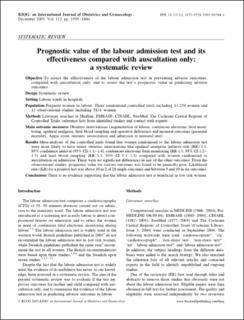| dc.description.abstract | Objective To assess the effectiveness of the labour admission test in preventing adverse outcomes,
compared with auscultation only, and to assess the test’s prognostic value in predicting adverse
outcomes.
Design Systematic review.
Setting Labour wards in hospitals.
Population Pregnant women in labour. Three randomised controlled trials including 11,259 women and
11 observational studies including 5831 women.
Methods Literature searches in Medline, EMBASE, CINAHL, SweMed, The Cochrane Central Register of
Controlled Trials, reference lists from identified studies and contact with experts.
Main outcome measures Obstetric interventions (augmentation of labour, continuous electronic fetal moni-
toring, epidural analgesia, fetal blood sampling and operative deliveries) and neonatal outcomes (perinatal
mortality, Apgar score, seizures, resuscitation and admission to neonatal unit).
Results Meta-analyses of the controlled trials found that women randomised to the labour admission test
were more likely to have minor obstetric interventions like epidural analgesia [relative risk (RR) 1.2,
95% confidence interval (95% CI) 1.1– 1.4], continuous electronic fetal monitoring (RR 1.3, 95% CI 1.2 –
1.5) and fetal blood sampling (RR 1.3, 95% CI 1.1 – 1.5) compared with women randomised to
auscultation on admission. There were no significant differences in any of the other outcomes. From the
observational studies, prognostic value for various outcomes was found to be generally poor. Likelihood
ratio (LR) for a positive test was above 10 in 2 of 28 single outcomes and between 5 and 10 in six outcomes.
Conclusions There is no evidence supporting that the labour admission test is beneficial in low risk women. | en_US |

